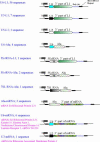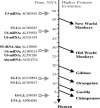The human genome contains many types of chimeric retrogenes generated through in vivo RNA recombination
- PMID: 12888497
- PMCID: PMC169886
- DOI: 10.1093/nar/gkg496
The human genome contains many types of chimeric retrogenes generated through in vivo RNA recombination
Abstract
L1 retrotransposons play an important role in mammalian genome shaping. In particular, they can transduce their 3'-flanking regions to new genomic loci or produce pseudogenes or retrotranscripts through reverse transcription of different kinds of cellular RNAs. Recently, we found in the human genome an unusual family of chimeric retrotranscripts composed of full-sized copies of U6 small nuclear RNAs fused at their 3' termini with 5'-truncated, 3'-poly(A)-tailed L1s. The chimeras were flanked by 11-21 bp long direct repeats, and contained near their 5' ends T2A4 hexanucleotide motifs, preferably recognized by L1 nicking endonuclease. These features suggest that the chimeras were formed using the L1 integration machinery. Here we report the identification of 81 chimeras consisting of fused DNA copies of different RNAs, including mRNAs of known human genes. Based on their structural features, the chimeras were subdivided into nine distinct families. 5' Parts of the chimeras usually originated from different nuclear RNAs, whereas their 3' parts represented cytoplasmic RNAs: mRNAs, including L1 mRNA and Alu RNA. Some of these chimeric retrotranscripts are expressed in a variety of human tissues. These findings suggest that RNA-RNA recombination during L1 reverse transcription followed by the integration of the recombinants into the host genome is a general event in genome evolution.
Figures




References
-
- International Human Genome Sequencing Consortium (2001) Initial sequencing and analysis of the human genome. Nature, 409, 860–921. - PubMed
-
- Kazazian H.H Jr (2000) Genetics. L1 retrotransposons shape the mammalian genome. Science, 289, 1152–1153. - PubMed
-
- Furano A.V. (2000) The biological properties and evolutionary dynamics of mammalian LINE-1 retrotransposons. Prog. Nucleic Acid Res. Mol. Biol., 64, 255–294. - PubMed
-
- Buzdin A., Ustyugova,S., Gogvadze,E., Lebedev,Y., Hunsmann,G. and Sverdlov,E. (2003) Genome-wide targeted search for human specific and polymorphic L1 integrations. Hum. Genet., 112, 527–533. - PubMed
Publication types
MeSH terms
Substances
Associated data
- Actions
- Actions

